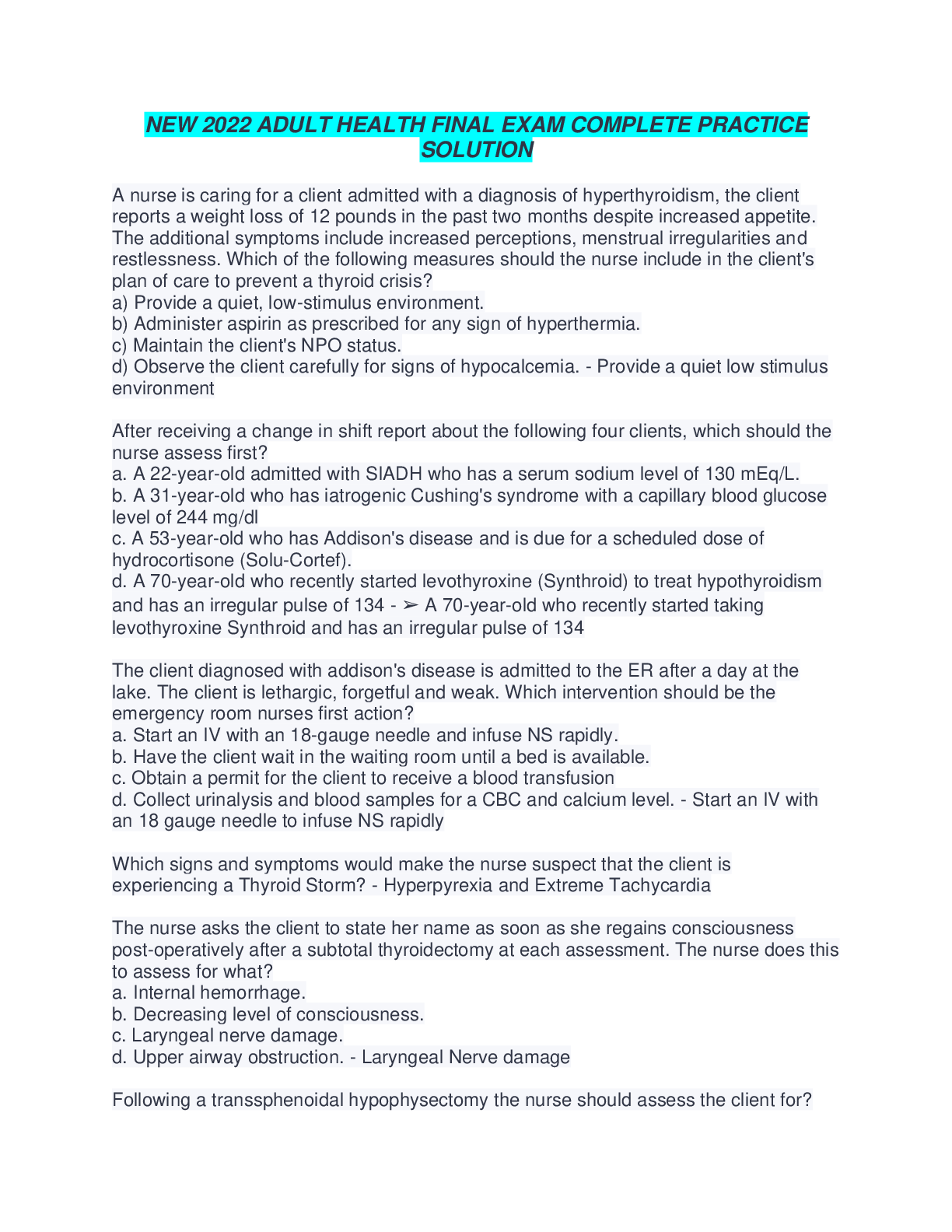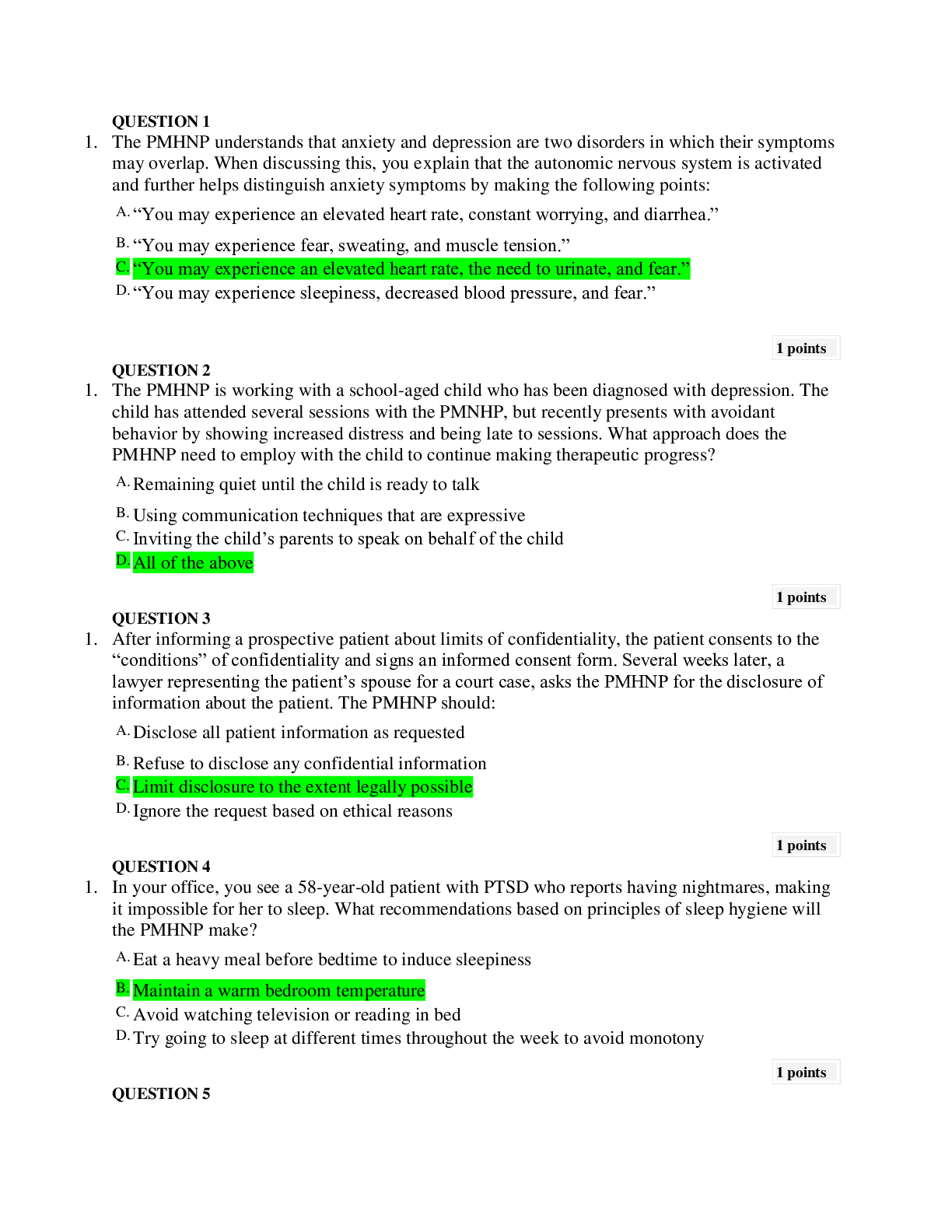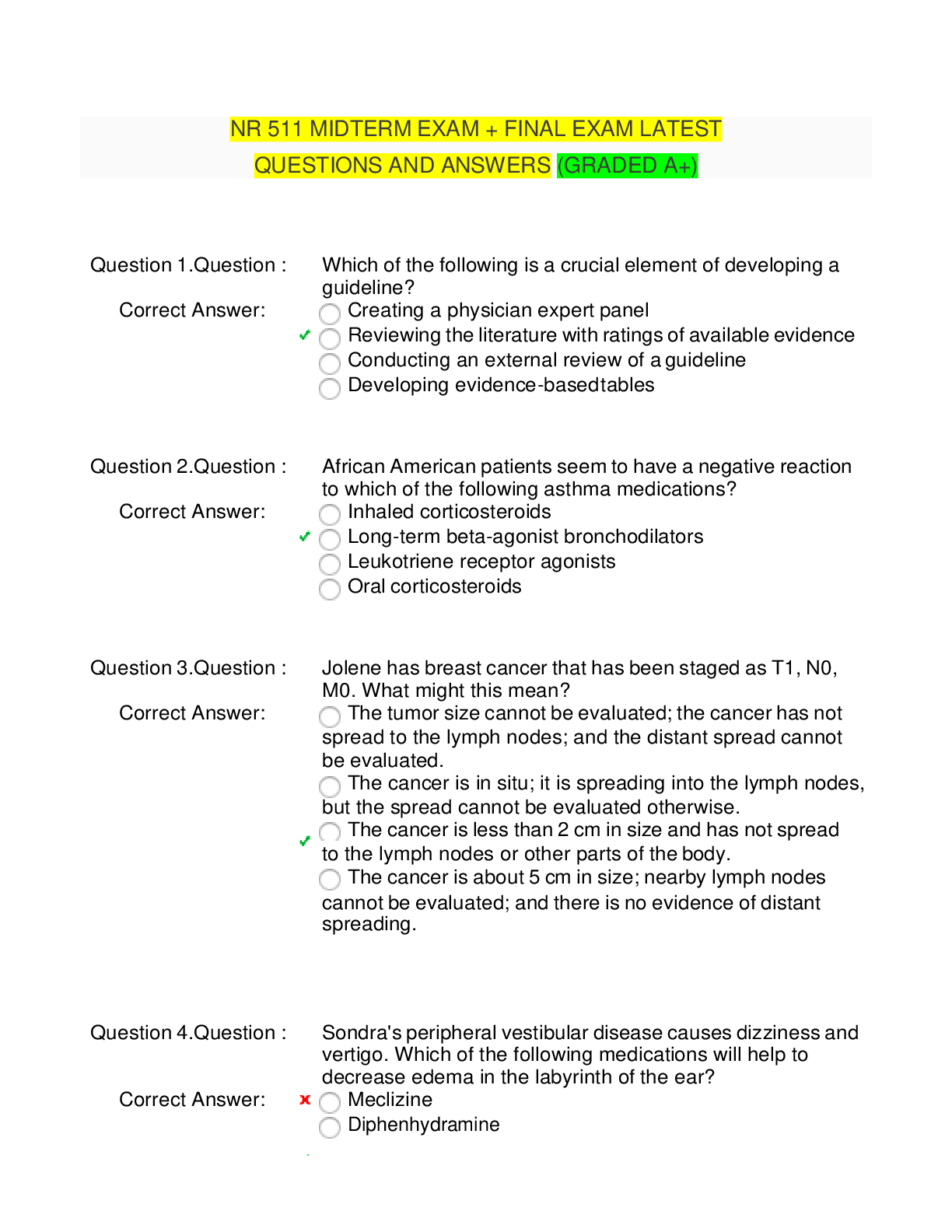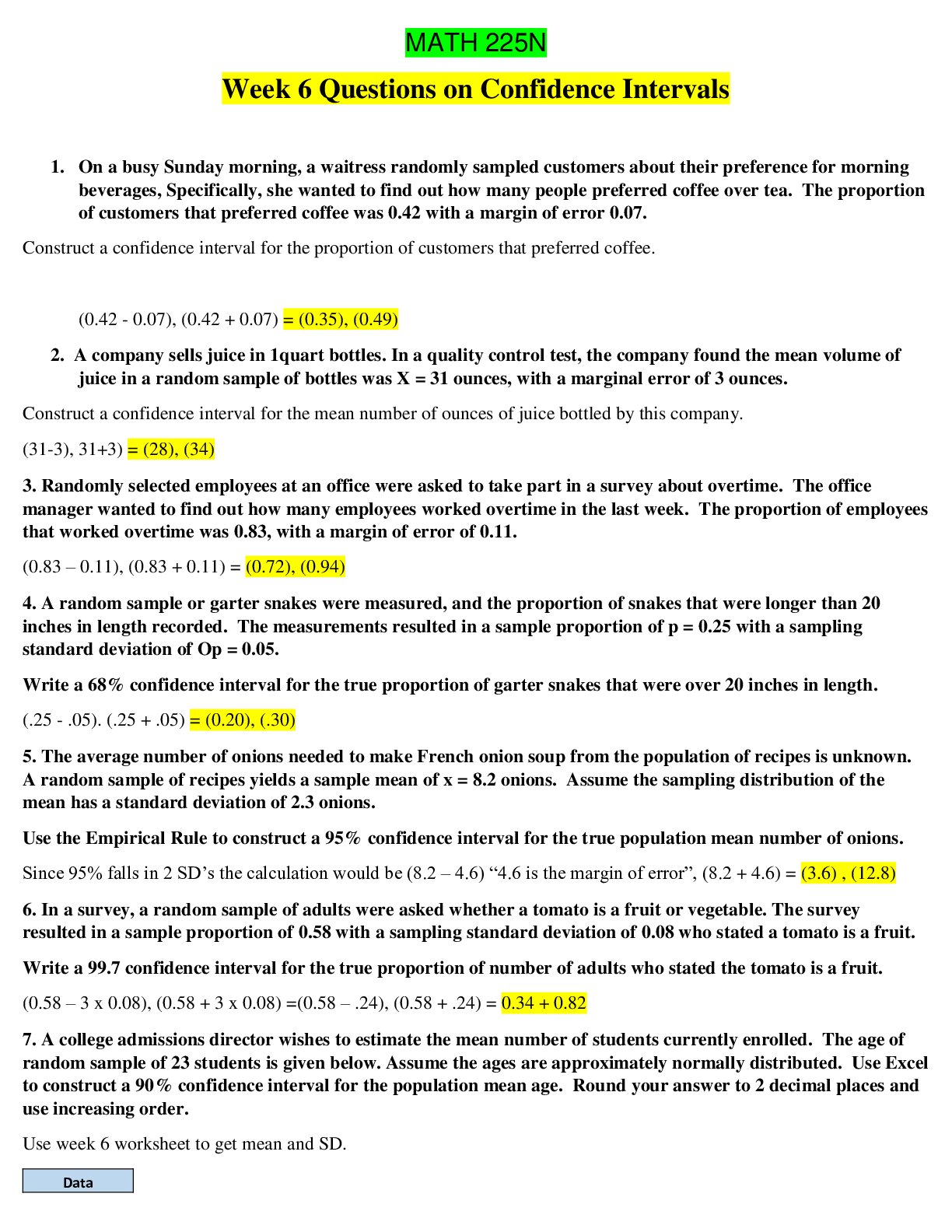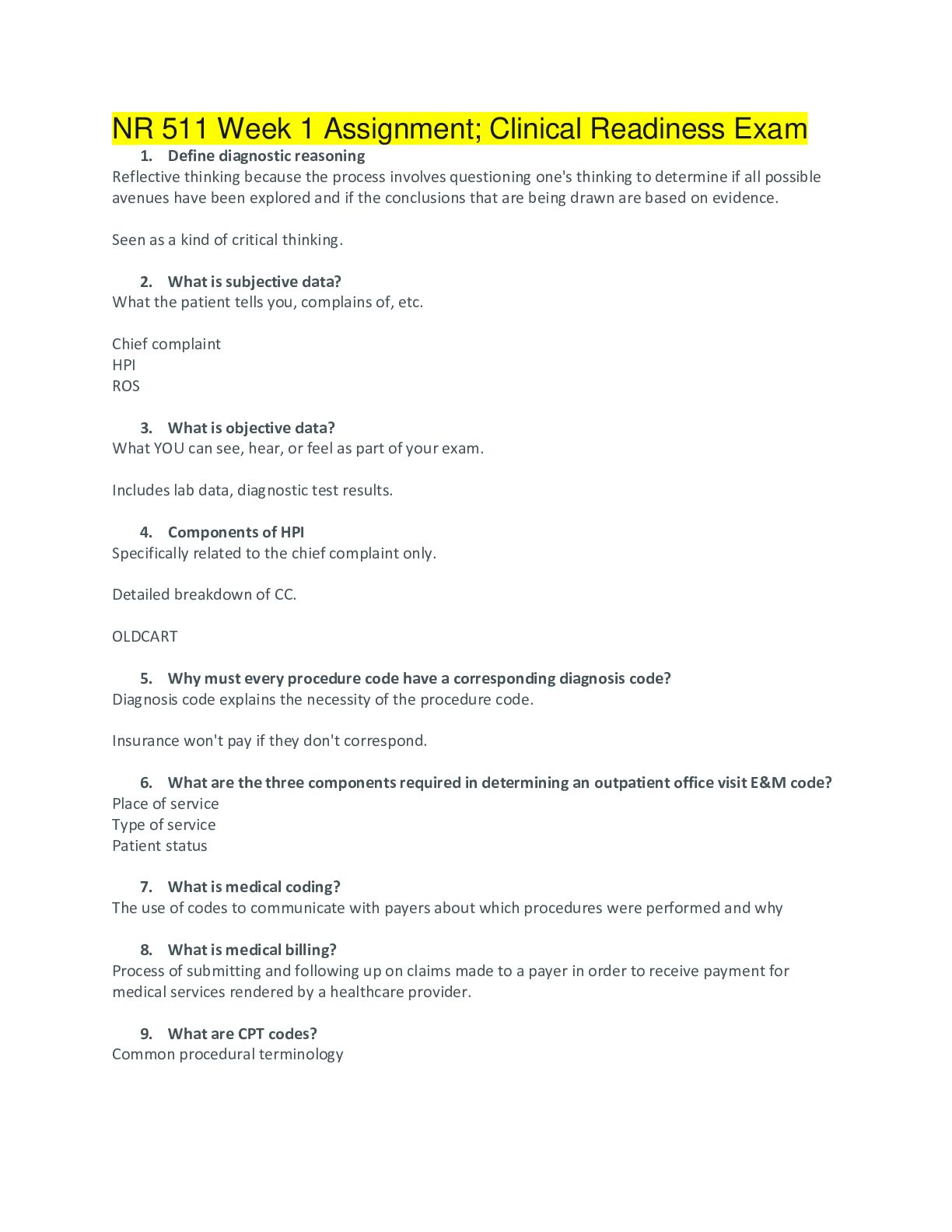*NURSING > EXAM > NURS C475 Care of the older Adult study guide OBjectives PRACTICE QUESTIONS AND ANSWERS SOLVED SOLUT (All)
NURS C475 Care of the older Adult study guide OBjectives PRACTICE QUESTIONS AND ANSWERS SOLVED SOLUTION 2021 Western Governors University
Document Content and Description Below
NURS C475 Care of the older Adult study guide OBjectives PRACTICE QUESTIONS AND ANSWERS SOLVED SOLUTION 2021 Western Governors University ⦁ How do you define Baby Boomers? Born between 1946-1964 ... ⦁ What are the five racial groups listed in text? European Americans, African Americans, Hispanic Americans, Asian Americans, and Native Americans. ⦁ How would you perform discharge teaching to an Hispanic patient? Involve family response to disagreement may be silence and non-compliance ⦁ How would you perform discharge teaching to a European American patient? possibly not as many close family ties trust in science/medicine ⦁ How would you perform discharge teaching to an Asian American patient? more closer to western, with emphasis on science health philosophy balance between individual and world traditional medicine focuses on regaining balance ⦁ How would you perform discharge teaching to an African American patient? include religion and spirituality, include family, account for distrust of medical community d/t hx of discrimination ⦁ How would you perform discharge teaching to a Native American patient Natualistic/magic approach Issues of trust with providers ⦁ What is the concept of individualized care? the standard of practice with older adults, considering the right care, at the right time, in the right place and by the right provider of care. ⦁ What are some visual changes related to aging? lens changes in color (more yellow), more opaque, denser, thinner and less flexible • pupil/iris- does not dilate as fully (more difficult to see in lower light) or contract as quickly (prob. sudden illumination ⦁ What are some communication accommodations that can be made for visual deficits? Position objects within visual field • verbal indications of actions about to impart • Large print type • avoiding dim-illumination or glare ⦁ What are some hearing changes related to aging? decreased sensitivity to pitch, with high-pitched consonants lost first (t, p, k, f, s, and ch) • Conductive problems - reduction of sound transmission - wave blocked from outer to inner. • Sesorinueral - sound wave transmission interrupted from inner ear to auditory cortex (possible damage to choclea and/or auditory nerve). ⦁ What is presbycusis? Old man's hearing - Presbycusis occurs following loss of hair and supporting cells and nerve fibers in the cochlea. ⦁ What are some communication accommodations that can be made for hearing deficits? Don't shout • Make use of unimpaired senses • Stand in front of pt in well-lit room • Limit background noise • short sentences, speak clearly • writing, pictograms, other modes ⦁ What are some speech/language changes associated with aging? ↓respirations strength, deeper voice and shaky/breathy • ↓saliva, teeth, elasticity and muscle tone may change articulation • cognitive changes may result in fewer words and making more semantic errors ⦁ What are some communication accommodations that can be made for speech/language deficits? environment low in distractions • close proximity (maintaining eye-contact) • rephrasing to check for comprehension ⦁ What are some somatosensory changes associated with aging? there is a reduction in tactile and vibration sensations as well as decreased sensitivity to warm or cold stimuli as we age , more prevalent in fingertips than other areas ⦁ What are some communication accommodations that can be made for somatosensory deficits? When engaging in physical activity with older adults, it is important to use verbal explanations to describe the physical activities as they take place. ⦁ What is an AAC? Augmentative and alternative communication (AAC): An integrated group of components or assistive devices and strategies that help individuals improve communication. ⦁ What are some communication tips for someone with dysarthria? Encourage the person to speak slowly and use simple sentences or single words. Allow time for the patient to respond. Don't try to complete their words or sentences. If there is no speech (aphasia, presence of an artificial airway, postoperatively after oral surgery): • Assess the individual's yes/no reliability. • Establish a system for yes/no communication (picture board or eye blink—1 = yes, 2 = no). Post rules for use at the bedside and in the medical record. • Ask yes/no questions and allow the person time to respond. Confirm response before acting. ⦁ Describe a BTE Behind the Ear BTEs are about 1 inch long and worn behind the outer ear. A small tube connects with the amplification device behind the ear and delivers amplified sound into the ear canal. The device has an adjustable volume control and is battery powered. It is the most common style of hearing aid. These devices are suitable for the entire range of hearing loss. ⦁ Describe an OTE Over the ear This is a new style that is very small and sits on top of the outer ear. ⦁ Describe an ITE In the ear ITEs are custom-fitted devices molded to the contour of the outer ear. The device has an adjustable volume control and a battery; however, both are much smaller than ones used in a BTE device. Some users have difficulty seeing or manipulating the control and battery. These devices are used for mild to moderate hearing loss. ⦁ Describe an ITC In the Canal ITCs are tiny devices that fit into the ear canal and are barely visible. They are customized to fit the size and shape of the ear canal. Although cosmetically appealing, their small size is a drawback for some individuals. ⦁ Describe a CIC Completely in the Canal CICs are the smallest type of device in the in the ear class. The entire device fits within the canal. Although cosmetically flattering, the small size is a true disadvantage because of difficulty handling and positioning the device. This device is the most expensive model of hearing aid. ⦁ What patients could benefit from an AAC? individuals with speech impairments ⦁ What are Satir's five principles of contact and communication? •invite • arrange environment • maximize communication • maximize understanding • follow through. #2 Competency 742.1.2: Health Promotion/Maintenance and Living Environments of Older Adults ⦁ What are the five A's to tobacco cessation? • Ask • Advise • Assess • Assist • Arrange ⦁ What are the Five R's to tobacco cessation? • Relevance • Risks • Rewards • Roadblocks • Repetition 3. What is the criterion for the pneumococcal vaccine? >65yo 4. What 5 areas do Healthy People 2010 and the USPSTF suggest that nurses focus on to promote health & prevent disability in the older adult? • Physical activity • Nutrition • Tobacco use • Safety • Immunization 5. Describe the difference between ADLs and IADLs (instrumental activities of daily living) • Activities of daily living (ADLs) are basic tasks that one needs to perform in order to survive • Instrumental activities of daily living (IADLs) are more complex tasks that include handling finances, preparing meals, or managing one's medications. 6. Review the USPSTF Screening Recommendations for Older Adults, Table 12-1 on page 376 in text. https://online.vitalsource.com/#/books/9781449679361/content/id/ch12table. 7. Review the I HATE FALLING risk assessment tool, Box 12-4 on page 361. What can the nurse recommend to reduce risk of falling? #3 Competency 742.1.3: Health Needs of Older Adults ⦁ What are the 5 most common geriatric syndromes? •pressure ulcers • incontinence • falls • functional decline • delirium, including hypokinetic delirium ⦁ What aspects of pharmacokinetics are affected by age-related changes? • Absorption • Distribution • Metabolism • Excretion • Pharmacodynamics ⦁ How is absorption of medications affected by age related changes? What is the significance? No significant changes in gastric pH; decreased absorptive surface and splanchnic blood flow Little significance; possibly delayed onset of action and peak effect of medications ⦁ How is distribution of medications affected by age related changes? What is the significance? • increased body fat (prolonged half-life of lipid soluble meds - benzodiazepines, phenytoin, phenothiazines) • decreased water compartment (Higher levels of water-soluble drugs (e.g., digoxin and theophylline), increasing risk for toxicity) • Decreased lean body mass (misread of creatinine levels leading to overestimate of kidney function) • Decreased serum albumin (Risk for toxicity of highly protein-bound drugs due to more free drug circulating) ⦁ What do you have to take into account when evaluating creatinine levels in the elder adult? Because creatinine is formed from muscle mass and muscle mass decreases with age, serum creatinine normally decreases with age; therefore, a serum creatinine level of ≤ 1.2 mg/dl could erroneously be perceived as WNL when in fact renal impairment exists; urine creatinine clearance is a better indicator of renal function in the elderly ⦁ How is metabolism of medications affected by age related changes? What is the significance? Decreased liver mass and hepatic blood flow (Slowed metabolism, increasing half-life) ⦁ How is excretion of medications affected by age related changes? What is the significance? Creatinine clearance reduced (Less efficiently excreted drugs, increasing half-life) ⦁ How is the pharmacodynamics of medications affected by age related changes? What is the significance? Variable receptor response (Increased response with some drugs (e.g., opiates and benzodiazepines) and decreased response with others (e.g., beta agonists and antagonists) ⦁ What are some functional changes and mobility issues that may threaten independence in the older adult? • decreased sensory acuity (vision, hearing, ↓proprioreception, etc). • dementia/AD • increased risks of falls ⦁ What are some factors that may contribute to alterations in nutrition in older adults? • multiple chronic illnesses • tooth or mouth problems that may interfere with their ability to eat • socially isolation • economic hardship • multiple medications that can cause changes in appetite or gastrointestinal symptoms • may need assistance with self-care ⦁ What are some examples of alterations in metabolism in older adults? • Changes in Vitamin D metab. may affect bone calcium. • Insulin resistance may increase. • alterations in thyroid function ⦁ What are some factors that may contribute to alterations in elimination in older adults? • Changes in blood flow and glomerular filtration rate (GFR) account for a majority of functional disability in the kidneys with age. With disease and some medications, blood flow and GFR can be further compromised. A decline in GFR becomes significant as people age because elimination of waste and toxins declines, causing an accumulation of harmful substances such as uric acid and medications in the body • Decreased drug clearance in the older population can occur due to the declines in liver size and blood flow as well as age-related changes in the kidneys, but this is highly variable among individuals ⦁ What are the signs and symptoms of pressure ulcers? Early: The skin becomes pale, then hyperemic and blanchable. Nonblanchable erythema is the result of plasma and erythrocytes leaking into the skin tissues. ⦁ What are the risks for pressure sores? • decreased sensory perceptions • exposure to moisture • decreased activity • decreased mobility • inadequate nutrition • increased friction or shear 17. Explain the difference between intrinsic and extrinsic risk factors for falls. • Intrinsic risk factors relate to the changes associated with aging and with disorders of physical functions needed to maintain balance • extrinsic: related to environmental hazards and challenges such as poor lighting, stairs, clutter, and throw rugs 18. What is a MAP? Medication Assistance Program Typically sponsored by pharmaceutical companies, a MAP provides a particular brand of medication at little or no cost to patients who meet certain financial criteria and do not have insurance coverage for prescription drugs. Even though most MAPs require some physician involvement in the application process, nurses can act as advocates to initiate the referral. 19. What are the Five Rights of Medication Administration? • drug • dose • route • time • person 20. Why are older adults more apt to polypharmacy? • multiple care providers • multiple medical problems • medication reconciliation may not be thorough 21. What are some ways to avoid polypharmacy? • complete medication reconcilliation (including OTC) with every visit • Only use one pharmacy for all their medications, including over the counter (OTC) and herbal remedies. The pharmacist can alert the patient to potential drug reactions. 22. What common classes of drugs cause ADRs? • antipsychotics • antihistamines • benzodiazepine (Atarax, restoril, florazepam, diazepam, Librium, Xanax, Restyl, Paxil), • Muscle relaxants • anti-anxiety drugs • anti-convulsants • antiemetics • analgesics #4 Competency 742.1.4: Promoting Independence and Autonomy While Reducing Risk Factors in Older Adults ⦁ What is autonomy? Referring to self-governance or self-directing freedom; being in charge of one's own being; having moral independence. ⦁ What is self-determination? the process by which a person controls their own life ⦁ What is frailty? General decline in physical function. ⦁ What are the characteristics of frailty? • unintentional weight loss of more than 10% in the prior year • feelings of exhaustion • grip strength in the weakest 20% for age • walking speed in the lowest 20% for age • low caloric expenditure (<270 kcal) per week on physical activity ⦁ What is the Kohlman Evaluation of Living Skills (KELS)? • assesses 17 daily living skills under five categories—self-care, safety and health, money management, transportation and telephone use, and work and leisure • used to evaluate the ability of the person to remain safely in the community while having his or her needs met in an appropriate manner 8. What are the factors that influence the quality of life of an older adult? 9. What is the one of the most common role changes faced by the aging person? List all. Retirement Others: • Health transition • Loss of spouse • role reversal 10. What is role reversal for the older adult? Role reversal with a spouse or adult children often occurs for the aging person, as the elder moves from care provider to care recipient through the course of aging. 11. List and the care options for the older adult (when independent living is no longer possible) • Independent living with help • Family • Adult daycare at a facility • Adult daycare at home • Senior living complexes/continuing care/supported care retirement communities • Assisted living • Paid caregiver homes (licensed or unlicensed) • Extended care facilities 13. Describe the care option of independent living with help Cooks, companions, homemaker/cleaning service—formal or informal. ⦁ Describe the care option of adult daycare at a facility Part-time temporary assistance, frequently for respite or while a family caregiver works; often used for persons with dementia or for the frail elderly needing assistance or at risk for social isolation. Usual discharge is to assisted living or death ⦁ Describe the care option of adult daycare at a home Part-time respite, as above. ⦁ Describe the care option of family Usually informal; may live in patient's or family member's home. ⦁ Describe the care option of adult daycare at Senior living complexes/continuing care/supported care retirement communities Full range or limited services, depending on the community and level of assistance needed; can be progressive as needs increase. ⦁ Describe the care option of assisted living Homelike setting with more physical and medical care available than in senior complexes. ⦁ Describe the care option of paid in-home caregivers Caregivers accept one or several nonrelatives into their home to receive 24-hour assistance, especially with BADLs, usually on a private-pay basis. In some states, public subsidies may cover adult group/foster home care. ⦁ Describe the care option of extended care facilities Skilled or intermediate care nursing home facilities for rehabilitation or ongoing care; can be paid by Medicare, Medicaid, or private pay, depending on financial resources. Preadmission screening is usually required by the state regulatory agency. What is the Borg Category Rating Scale? ⦁ What are the common signs of abuse in an older adult and who is mostly to be the abuser? • The presence of several injuries in different stages of repair • Delays in seeking treatment • Injuries that cannot be explained or that are inconsistent with the client's history • Contradictory explanations by the caregiver and the patient • Bruises, burns, welts, lacerations, or restraint marks • Dehydration, malnutrition, decubitus ulcers, or poor hygiene • Depression, withdrawal, or agitation • Signs of medication misuse • A pattern of missed or cancelled appointments • Frequent changes in health care providers • Discharge, bleeding, or pain in the rectum or vagina or a sexually transmitted disease • Missing prosthetic device(s), such as dentures, glasses, or hearing aids ⦁ Who is mostly to be the abuser? Most cases of elder abuse are perpetrated by a family member, and reasons for the abuse include caregiver burnout and stress, financial worries, transgenerational violence, and psychopathology in the abuser. Women and dependent elders tend to be the most vulnerable to abuse. ⦁ List common tools used to assess abuse in the older adult • Hwalek-Sengstock Elder Abuse Screening Test • Vulnerability to Abuse Screening Scale ⦁ Describe the Framingham Heart Study. What did it look at and what were the findings? This study began with over 5,000 male and female subjects about 50 years ago in order to study cardiovascular risk factors. As a result of decades of epidemiologic work, the following risk factors have been identified: • Age greater than or equal to 50 for men and 60 for women • Hypertension • Smoking • Obesity • Family history of premature CHD • Diabetes (considered to be a CHD risk-equivalent, i.e., carries the same risk of a coronary event as known CHD) • Sedentary lifestyle • Abnormal lipid levels (Expert Panel on Detection, Evaluation, and Treatment of High Blood Cholesterol in Adults, 2001) ⦁ What are the risk factors for stroke? • increased age • hypertension • smoking • diabetes ⦁ How does a-fib affect stroke risk? It is estimated that 36% of strokes suffered by clients 80-89 years of age are as a result of nonvalvular atrial fibrillation (National Stroke Association, 1999). Adequate anticoagulation with warfarin therapy in patients with atrial fibrillation has been found to reduce stroke occurrence by 68%. Aspirin therapy was found to reduce CVAs by only 21%. It is based on these data that National Stroke Association guidelines recommend the use of oral anticoagulation with warfarin for patients older than 75 years of age with nonvalvular atrial fibrillation. ⦁ Describe thyroid dysfunction risks in the elder adult Overt disease affects 5% of American adults, but the prevalence of subclinical hypothyroidism (elevated thyroid-stimulating hormone [TSH] with normal levels of thyroid hormone) is 17.4% among women older than age 75 and 6.2% among men over age 65. Approximately 2-5% of these cases of subclinical hypothyroidism will progress to overt hypothyroidism each year. ⦁ Describe osteoporosis risks in the elder adult Half of all postmenopausal women will have a fracture related to osteoporosis at some point in their life. The risk for the development of osteoporosis markedly increases with age, and osteoporosis is responsible for 70% of the fractures that occur in older adults. Women ages 65-69 have 6 times the risk of osteoporosis than younger postmenopausal women, and that rate increases to 14 times in women ages 75-79 (USPSTF, 2004). Age, low body mass index (BMI), and failure to use estrogen replacement are the strongest risk factors for osteoporosis development. ⦁ Describe visual dysfunction risks in the elder adult About 4% of adults ages 65-74 and 16% of those 80-84 years of age have bilateral visual acuity worse than 20/40. Macular degeneration is the most common cause of visual loss in elderly whites, whereas African Americans are more likely to lose vision as a result of cataracts, glaucoma, and diabetes. Visual impairment has been correlated with falls and hip fractures in the elderly (Ivers et al., 2003). ⦁ Describe prostate cancer risks in the elder man Prostate cancer is both the second most common form of cancer among U.S. men and the second leading cause of cancer death in U.S. men. The risk of developing prostate cancer increases with age and is the second leading cause of death in American men (American Cancer Society, 2008). The disease is most prevalent in African Americans and least prevalent among Asian Americans. 33. Two tests are commonly used in prostate cancer screening: the digital rectal exam (DRE) and the prostate-specific antigen (PSA) blood test. 34. Describe breast cancer risks in the elder adult Breast cancer is the most common cancer among U.S. women, and the prevalence of the disease increases with age. According to the CDC (2008), 3-4% of women who are 60 years old today will get breast cancer by the age of 70. Other risk factors for the disease include family history of breast cancer, atypical hyperplasia in breast tissue, and birth of a first child when a woman is over 30 years of age. There is fair evidence to support benefit from breast cancer screening for older women by mammogram every 1-2 years. There is no age at which screening should be discontinued, but the task force agrees that screening would have no benefit when life expectancy is significantly limited by dementia or other serious, life-limiting chronic illnesses. 35. Describe colorectal cancer risks in the elder adult Colorectal cancer is both the third most common cancer in the United States and the third leading cause of cancer death in the United States. The prevalence of the disease increases with age, and over 90% of colorectal cancer is diagnosed in clients over the age of 50 There are several good screening methodologies to detect early colon cancer: fecal occult blood testing (FOBT), sigmoidoscopy, and colonoscopy. Choice of screening test is determined based on client risk factors and preference. Patients who have a history of adenomatous polyps or inflammatory bowel disease, or a family history of colorectal cancer or adenomatous polyps, should receive colonoscopy. Screening for these high-risk clients is begun before age 50. 37. What dc instructions might a nurse give to a patient regarding pharmacies and medication safety? Instruct the patient to obtain all medications (prescription and nonprescription) at one pharmacy so that pharmacists can check for potentially dangerous interactions. The pharmacist can serve as the central figure who maintains a list of medications and screens for drug-drug interactions to avoid harmful situations. #5 Competency 742.1.5: Promoting Health and Independence in Older Adults What is the definition of a fall? An event which results in a person unintentionally coming to rest on the ground or another lower level; not as a result of a major intrinsic event (such as a stroke) or overwhelming hazard What can happen to an older adult after a fall? • injury • loss of independence • reduced quality of life • death Fractures are the most serious health consequence of falls. What is the biggest risks for falls? past history of falls What are intrinsic risk factors for falls? Intrinsic risk factors relate to the changes associated with aging and with disorders of physical functions needed to maintain balance. These functions include: • Cognitive impairment • Medication/alcohol • Impaired mobility • Fall history • Acute or chronic illness • Elimination problems • Sensory defects • Frailty • Postural hypotension Elderly persons who fall in institutions are usually more physically and/or cognitively impaired, and therefore intrinsic factors contribute most to falls and fall-related injuries What are extrinsic risk factors for falls? Extrinsic risk factors are related to environmental hazards and challenges such as: • Poor lighting • Poor color distinction • Cluttered environment • Unfamiliar environment • Stairs • Throw rugs • Unsuitable footwear • Restraints • Side rails Among older adults living in the community, when and where do most falls occur? During usual activities such as walking. Indoor falls occur most often in the bathroom, bedroom, and kitchen. About 10% of falls occur on stairs, with descent being more hazardous than ascent. The first and last steps are the most dangerous. Common sites of outdoor falls are curbs and steps. What can you do to prevent falls? • Fall assessment • Modify environment • Evaluate Gait and Balance • Review Medications • Develop a fall prevention plan • Reduce Restraint Use What are some ways you can modify the inpatient environment to prevent falls? • orientation to the environment with an emphasis on safety devices • nonskid slippers or shoes • hip protectors • removal of obstacles and clutter • having the commode close to the bed • having the call light within easy access • encouraging use of glasses and hearing aids • avoidance of physical restraints, such as raised side rails • maintaining the bed in the lowest position What medications should you pay particular attention to when assessing fall risk? Drugs that affect mobility such as sedatives, hypnotics, psychotropics, and antihypertensives What are some ways you can modify the home environment to prevent falls? What are the types of restraints used? physical or chemical What is a physical restraint? any physical or mechanical device (e.g., waist restraint, wrist restraint, geriatric chair) that involuntarily restrains a patient as a means of controlling physical activity What is a chemical restraint? the use of a psychopharmacological drug for the purpose of discipline or convenience, and not to treat medical symptoms What are the effects of restraint use on the elderly? • increased agitation/confusion • increased risk of falls • physical reconditioning d/t decreased mobility • increased risk of skin breakdown What are alternatives techniques (instead of restraints) to deal with wandering, combative or confused patients? • companionship or supervision • changing or eliminating bothersome treatment • environmental manipulations • reality orientation • psychosocial interventions • diversionary and physical activities • bed alarms or roam alerts What are the two most widely publicized components of health promotion? Exercise and nutrition What are some of the preventive care services covered under Medicare? • One time "Welcome to Medicare Physical • Cardiovascular screening every 5 years • Cervical cancer screening every 2 years • Colorectal cancer: annually for fecal occult blood test; every 4 years for sigmoidoscopy or barium enema • Densitometry: covered every 2 years • Diabetes screening annually • Mammogram covered annually • Prostate cancer covered annually • Smoking Cessation: Two quit attempts annually • Immunization: Influenza vaccination covered annually; pneumococcal vaccination covered one time, revaccination after 5 years dependent on risk. Describe a health contract Relies on the self-management capability of a client, after initial assistance is provided by a clinician or health educator. The client is helped to choose an appropriate behavior change goal and to create and implement a plan to accomplish that goal. The statement of the goal and the plan of action are then written into a contract format. Explain Bailey's Bull's eyes The goal of the bull's-eye is for people to consume the nutritious foods that are listed in the center of it. Describe Healthy People 2000 A continuation of the 1980 Report, Promoting Health/Preventing Disease: Objectives for the Nation, that outline 226 objectives for the nation to achieve over the following 10 years. Healthy People 2000, was initiated in 1990 by the U.S. Public Health Service in another effort to reduce preventable death and disability for Americans. Describe Healthy People 2010 A continuation of Healthy People 2000; however, the number of objectives has increased to 467, and these are distributed over 28 priority areas. Define health promotion vs. health screening health promotion: the process of enabling people to increase control over their health and its determinants, and thereby improve their health (think primary prevention) health screening: Screening, in medicine, is a strategy used in a population to identify an unrecognized disease in individuals without signs or symptoms. Screening interventions are designed to identify disease in a community early, thus enabling earlier intervention and management in the hope to reduce mortality and suffering from a disease. (think secondary prevention) What are the three types of prevention? • primary • secondary • tertiary What is primary prevention? activities designed to completely prevent a disease from occurring, such as immunization against pneumonia or influenza What is secondary prevention? efforts directed toward early detection and management of disease, such as the use of colonoscopy to detect small, cancerous polyps What is tertiary prevention? efforts used to manage clinical diseases in order to prevent them from progressing or to avoid complications of the disease, as is done when beta blockers are used to help remodel the heart in congestive heart failure What is the chronic disease self-management program (CDSMP)? a 17-hour course for patients with chronic diseases that is taught by trained laypeople. The course goal is to teach patients to improve symptom management, maintain functional ability, and adhere to their medication regimens. What are the barriers to physical activity for the older adult? • lack of access to safe areas to exercise • pain • fatigue • impairment in sensory function and mobility What is the major risks of a sedentary life style? Heart disease and stroke What are the four leading causes of death in the US? • cancer • diabetes • coronary heart disease • cerebral vascular accidents Why might older adults be at risk for poor nutrition? • multiple chronic illnesses • may have tooth or mouth problems that may interfere with their ability to eat • may be socially isolated • may have economic hardship • may be taking multiple medications that can cause changes in appetite or gastrointestinal symptoms • may need assistance with self-care What is a healthy BMI? When might we be concerned? The Nutrition Screening Initiative suggests that a BMI of 22-27 is considered normal. Values above or below this range suggest over- and underweight, respectively. Unintended weight loss is a nutritional risk that requires additional assessment. Obesity is a problem for many older Americans, just as it is for younger adults. What lab values might show malnutrition in the older adult? Serum albumin: Less than 3.5 g/dl is associated with malnutrition and increased morbidity and mortality Are older adults at risk for alcohol abuse? If they are, what can be done to re-educate them and prevent harm? Duh. They are human. Yes. • Five A's - willing to quit • Five R's - not willing to quit What are the five A's for a patient wishing to quit an unhealthy habit? • Ask • Advise • Assess • Assist • Arrange What are the five R's for a patient not willing to quit an unhealthy habit? • Relevance • Risks • Rewards • Roadblocks • Repetition #6 Competency 742.1.6: Technology-Assisted Care of Older Adults What is the goal of assistive technology? Assistive technology is designed to help us with the loss of strength, balance, visual and auditory, cognitive, and/or memory changes that occur as we age & bridge the gap between capabilities and care needs. What is assistive technology? Anything that can enhance the function of some physical or mental ability that is impaired. It can be a cane, walker, glassed, hearing aids, wheelchair, bath bench, elevated toilet seat Which type of patients are more likely to use assistive devices? patients who are impaired or at risk for needing assistive devices What are some potential barriers to adult learning? • chronic illnesses • normal aging changes occurring with advancing age • health disparities, • other factors that may accompany cultural diversity. What are the guidelines for Introducing Technology and Teaching the Elderly About Its Use • The use of technology must be perceived as needed and meaningful, and must be linked to the lifestyle of the person. • Cautions and disbelief in one's capability may be an obstacle in accepting new technology and must be considered when creating the learning environment. • A generous amount of time as well as repeated short training sessions should be allowed. • More stress should be placed on the practical application of the device than on its technical features. • Only selective, central facts should be presented. • Mnemonics and cues will favorably affect self-efficacy in handling new products. • Training sessions should be held in the home or natural meeting places of the elderly. • The instructor should be well known by the elderly or introduced well in advance of the training. • The attitudes of the instructors toward the aged must be positive and realistic. What are some ways in which the Nursebot robot may assist with the elderly? • Intelligent reminding • Tele-presence (less frequent MD visits) • Data collection and surveillance (monitoring) • Mobile manipulation (assisting with heavy objects, etc.) • Social interaction deprivation What may we see with sensor-based monitoring systems in the future? A system to enable older adults with disabilities to remain in their own homes for as long as possible. The system is composed of unobtrusive and low-cost sensors (no cameras or microphones) that detect movement and pressure. #7 Competency 742.1.7: Health Care Systems and Reform What are the intentions of the Affordable Care Act? 1. Eliminate lifetime limits for health insurance coverage for essential services 2. Eliminate the ability of insurance companies to rescind coverage 3. Free Preventative care 4. Development of a prevention and public health fund. 5. Increase access to affordable care, including a provision for preexisting 6. Quality improvement and risk reduction What is the Independence at Home Demonstration? NP's worked with patients to help them experience a higher level of independence through better management of their chronic illnesses What provisions of the ACA have already taken effect? 1. Improved drug discounts for Medicare recipients 2. Coverage for young adults through parental health insurance until age 26. 3. Expanding coverage for early retirees 4. National preexisting-condition insurance plan to assist those individuals without coverage for at least 6 months due to a prior condition. 5. 2012 mandate The US Supreme Court upheld provisions to expand Medicaid and Medicare coverage a. The Medicare expansion program requires participating states to expand coverage to most individuals under the age of 65 with income below poverty levels outlined in the Act. 6. The intent of PPACA in terms of Medicare is to reduce overall cost while maintaining coverage to those entitled to Medicare. 7. A national Medicare pilot program will be developed to provide Medicare recipients with more options for long-term care, including primary care services in their homes rather than institutional care. 8. Increase services that will impact the older population include providing wellness and prevention programs at no cost to the individual and prescription drug discounts. What does Medicare Part A cover? • cover inpatient hospital care • inpatient care in a skilled nursing facility (for transitional, but not custodial care) • hospice care • home health care services What does Medicare Part B cover? some of the cost for laboratory services, home health care services, doctor services, some outpatient therapies, mental health services, and outpatient hospital services. What does Medicare Part C cover? This option offers managed care plans like health maintenance organizations (HMOs) and preferred provider organizations (PPOs). Medicare Advantage plans provide all of the benefits of the hospital and medical insurance plans under original Medicare, but can charge different copayments and deductibles. What does Medicare Part D cover? Offers multiple prescription plans from which the beneficiary can choose. Each plan identifies the prescription medication it covers as well as the pharmacy, premium, deductible, and copayment. Consequently, the beneficiary must determine the plan that covers most of the medications prescribed as well as determine whether to choose a higher premium or higher deductible. What does Medicaid cover? Medicaid provides three types of health protection: 1) health insurance for low-income families and people with disabilities, 2) long-term care (LTC) for older Americans and persons with disabilities, and 3) supplemental coverage for low-income Medicare beneficiaries for services not covered by Medicare (e.g., eyeglasses, hearing aids, prescription drugs) as well as Medicare Part B premiums and Medicare Parts A and B deductibles and copayments Who is eligible for Medicare? those 65 or over who have paid into the Social Security system, the railroad fund, or are diagnosed with end stage renal disease. Those collecting Social Security Disability Insurance (SSDI) are eligible for Medicare after a 24-month waiting period. How is Medicare Part B funded? Not mandatory and is not funded by the Medicare trust fund. Participants may pay for Part B out of their Social Security checks. In 2008, premiums for Medicare Part B were based on income; Who is eligible for Medicaid? Different in each state, each state does require an individual and family to use their own resources (spend down) before they can become eligible to receive Medicaid reimbursement for LTC. Are nursing homes covered by Medicare? No - it's through Medicaid What is Triple Aim of healthcare reform? • Improving the patient experience of care (including quality and satisfaction) • Improving the health of populations • Reducing the per capita cost of health care. Can a person over 65 qualify for Medicare if they have not paid into Medicare taxes for a total 10 years? If an individual is 65 years of age and has not worked 10 years (40 quarters) in a job that has paid Medicare taxes, he or she can still receive Medicare Part A by paying a premium. What is a healthcare premium? Premium is the amount of money you have to pay for insurance. Premiums are usually paid in monthly or quarterly installments. What is a healthcare deductible? Deductible is the amount of money you pay for eligible medical expenses in a calendar year. After deductible is met, you pay nothing or you share the remaining costs with you company up to out-of-pocket maximum. #8 Competency: Care Transitions Describe A Shift to Different Living Facilities as a Transition Model A move away from traditional nursing homes: • Continuing care retirement communities (CCRCs) • Green Houses What are Continuing care retirement communities (CCRCs)? Offers various levels of care on a continuum that might include independent living, assisted living, skilled care, and home health services all on one campus. The trend will be to bring services to the CCRCs versus transferring persons to the next level of care on the continuum (for example, sending them to the "nursing home" when their care demands increased). What is a Green House? Consist of 10-12 residents in a home setting who enjoy private rooms and share a common living space (Lagnado, 2008). Instead of the institutional-like setting of many aging nursing homes, Green Houses are designed to provide a full range of care services, but in a friendly atmosphere that reminds one of home. What is a professional geriatric care manager (PGCM) ? a specialist who helps families care for older adults while encouraging as much independence as possible. Although PGCMs may come from a variety of backgrounds such as social work, psychology, sociology, geriatrics, and nursing, nurses have emerged as natural leaders in this growing field What services may a PGCM perform? • Conduct assessments • Develop care plans that address pertinent problems • Arrange, interview for, and monitor in-home caregivers or other services • Act as a consultant for caregivers who live near or far • Review financial, health-related, or legal issues • Provide referrals to other geriatric specialists • Intervene in times of crisis • Act as an advocate and/or liaison between families and service providers • Keep the family informed of any problems • Coordinate or oversee care • Assist with transitions in living arrangements, including recommending the most appropriate settings and helping facilitate the move • Provide education and links to resources • Offer counseling and support • Some PGCMs also offer guardianship, caregiving, and/or financial services What is the difference between multidisciplinary and interdisciplinary teams? Multidisciplinary teams function as a group (multiple) of professionals who work loosely in the same area or with the same client. Interdisciplinary teams are an interconnected group of professionals who have common and collective goals. Another way to describe multidisciplinary and interdisciplinary is to see multidisciplinary as sequential, with each discipline applying its assessment and intervention within its own silo (Siegler et al., 1998), whereas interdisciplinary teams have an interactive approach to care. Who is usually on an interdisciplinary team? the "who" in a team can include any number of health care professionals along with the client and family or caregiver. If, instead of a series of appointments, a geriatric team provided assessments, this might be accomplished in a consultative assessment visit with the team. May include: • Audiologist • Caregiver • Dietician • Geriatrician • Minister • Patient • Nurse (RN, GNP, GCNS) • OT • PT • Pharmacist • Physician • PA • psychiatrist/psychologist • social worker • speech therapist What is the nurse's role in the multidisciplinary team? the nurse functions effectively within nursing and inter-professional teams, fostering open communication, mutual respect, and shared decision-making to achieve quality patient care #9 Competency 742.1.9: Palliative and End-of-life Care What is curative care? life-prolonging, and acute care options focus on cure What is palliative care? whole-person care for those persons with life-limiting illnesses who are not yet eligible for hospice support, can be a bridge between curative and hospice care, can deal with symptom management What is hospice care? provides care and support for persons in the last phases of incurable disease so they may live as fully and comfortably as possible. Hospice recognizes dying as part of the normal process of living, and focuses on maintaining the quality of remaining life. What is an advance directive? Advance directives are legal documents that allow you to spell out your decisions about end-of-life care ahead of time. What if there is no advance directive or living will? The absence of a living will or "do not resuscitate" order requires that all possible efforts at resuscitation should be initiated. What is a living will? A living will tells which treatments you want if you are dying or permanently unconscious What is the nurse's role in advance directives/living wills? The nurse supports the preferences of the patient in resolving self-determination issues. What are the signs of impending death? • Surge of energy • Decrease in blood pressure • Eyes glassy/tearing/half open • Irregular breathing • Restlessness or no activity • Purplish/blotchy knees, feet, hands • Pulse weak and hard to find • Decreased urine output • May wet or stool the bed • "Fish out of water" breathing • Cannot be awakened What is nociceptive pain? somatic and visceral pain What are the symptoms of somatic nociceptive pain? Tissue injury resulting in stimulation of afferent nerve endings. • The skeletal system, soft tissue, joints, skin, or connective tissue. • The patient typically can localize the pain, may be able to point with finger to area; may describe as dull, aching, throbbing, or gnawing in nature. • Examples: bone fracture, bone metastases, muscle strain. What are the treatments for somatic nociceptive pain? Best treated with NSAIDs or steroids, and partially responsive to opioid therapy; may require a combination. What are the symptoms of visceral nociceptive pain? Activation of nociceptors • Internal organs • Patient often unable to localize; may use an open hand to show area affected, because pain may be diffuse • May describe as deep, aching, cramping, or sensation of pressure • Examples: shoulder pain, secondary to lung or liver metastases What are the treatments for visceral nociceptive pain? Very responsive to opioid therapy What is neuropathic pain? Injury to peripheral nerves or central nervous system • May be described as shooting, stabbing, burning, or shock-like • May be constant or intermittent • Examples: herpes zoster or diabetic neuropathy What are the treatments of neuropathic pain? Less responsive to opioids; responds best to anticonvulsants or tricyclic antidepressants Should an older adult in pain and receiving palliative care be concerned with addiction? No - The findings of several studies have shown that addiction as a result of using opioids for pain relief occurs in less than 1% of patients What is drug dependence? Physical response to use of opioids, characterized by withdrawal symptoms when the opioid is stopped. What is drug tolerance? Decrease in one or more effects of an opioid, usually due to disease progression; may be treated with increased doses with few clinical problems in the terminally ill. What are the five wishes in regard to end of life care? • The person chosen to make decisions when the individual can no longer make them for himself or herself—a durable power of attorney for health care • The kind of treatment the person wants or doesn't want—a living will • How comfortable the person wants to be • How the person wants to be treated by others • What the person wants his or her loved ones to know [Show More]
Last updated: 1 year ago
Preview 1 out of 76 pages

Buy this document to get the full access instantly
Instant Download Access after purchase
Add to cartInstant download
We Accept:

Reviews( 0 )
$13.50
Document information
Connected school, study & course
About the document
Uploaded On
Feb 13, 2021
Number of pages
76
Written in
Additional information
This document has been written for:
Uploaded
Feb 13, 2021
Downloads
0
Views
33

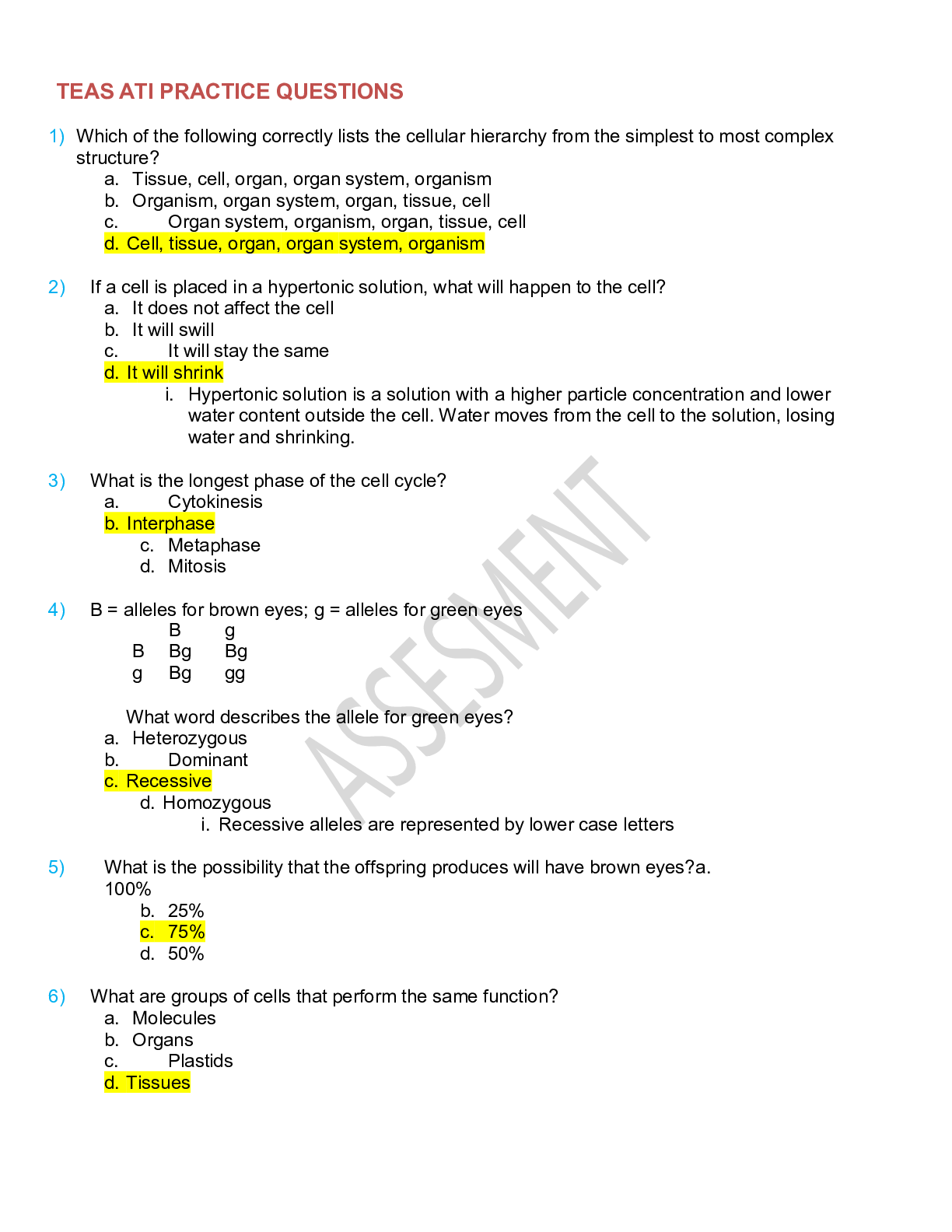



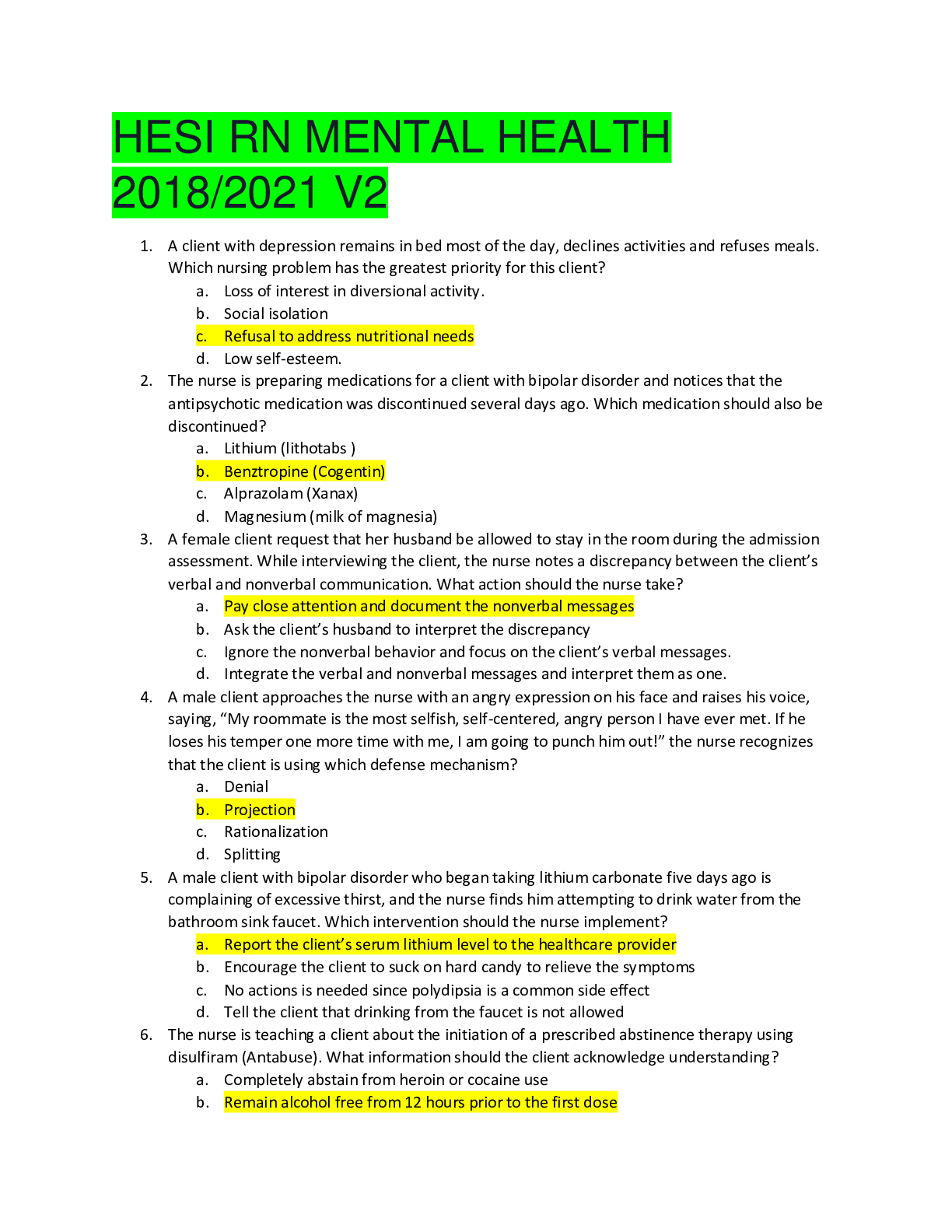
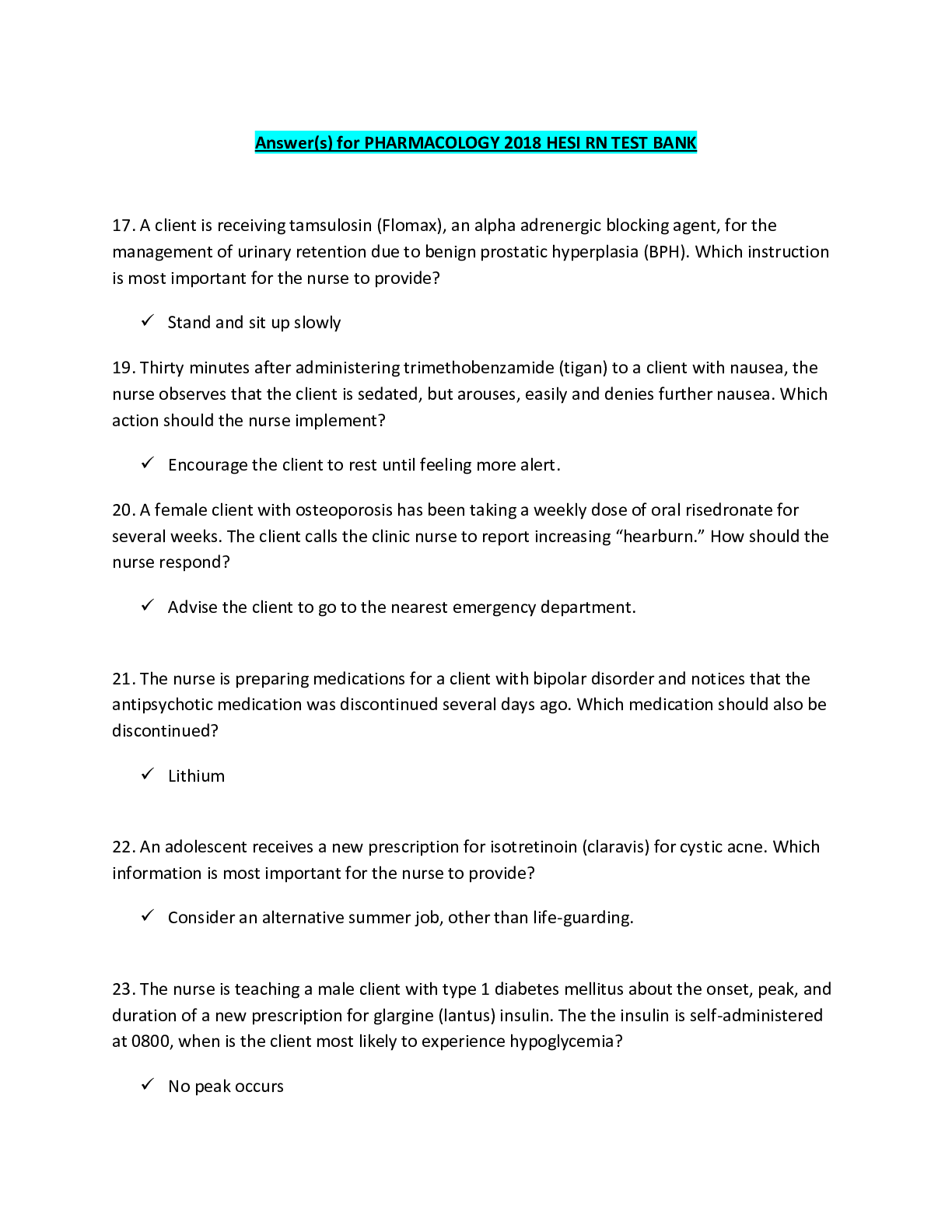

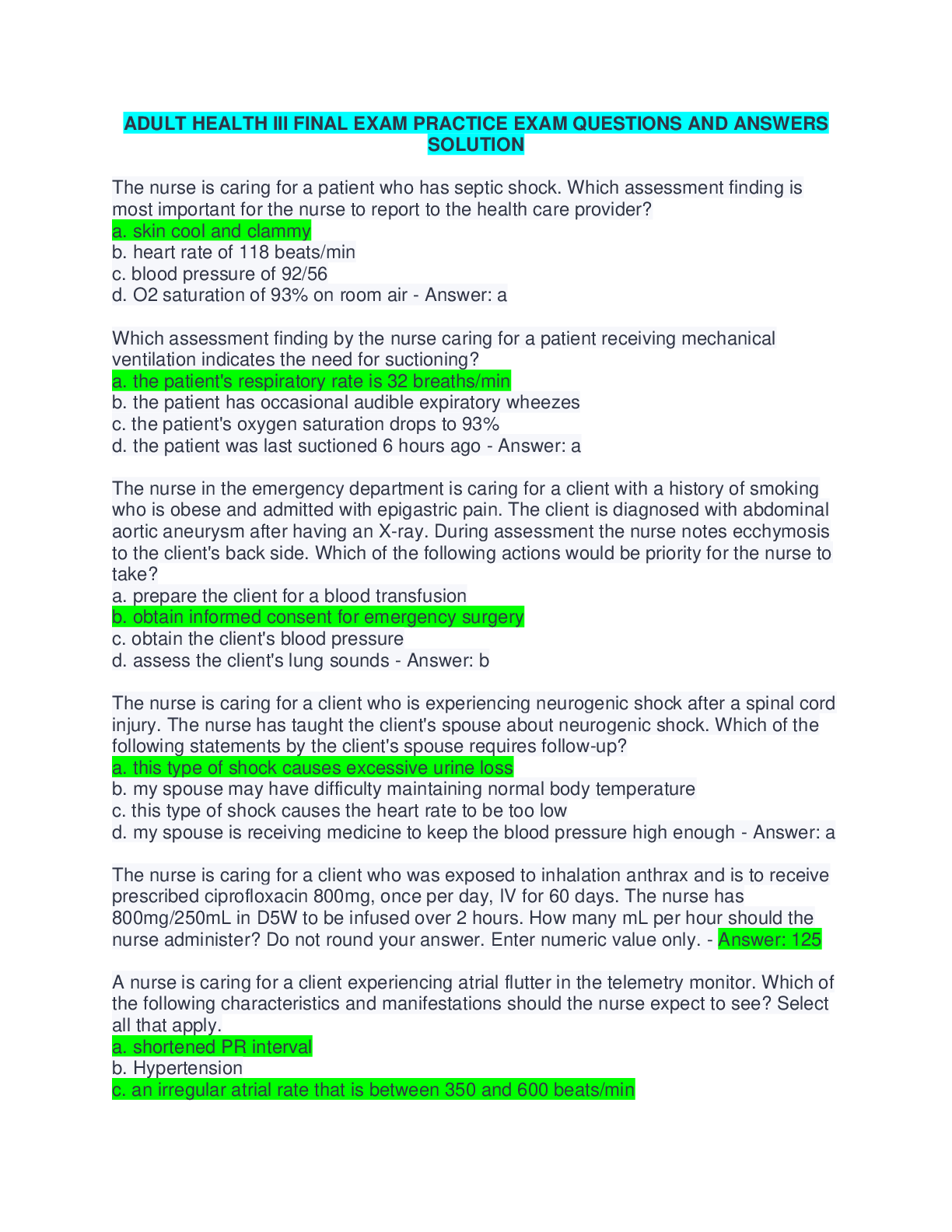


 GRADED QUESTIONS AND ANSWERS.png)
